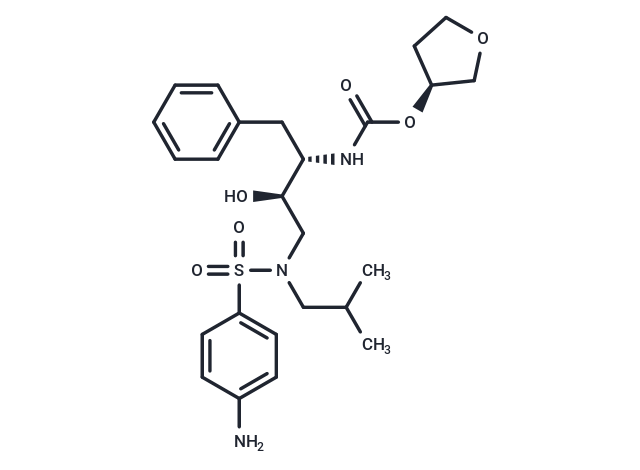Shopping Cart
- Remove All
 Your shopping cart is currently empty
Your shopping cart is currently empty

Amprenavir (KVX-478) is a synthetic derivative of hydroxyethylamine sulfonamide that selectively binds to and inhibits human immunodeficiency virus (HIV) protease.

| Pack Size | Price | Availability | Quantity |
|---|---|---|---|
| 5 mg | $45 | In Stock | |
| 10 mg | $77 | In Stock | |
| 25 mg | $128 | In Stock | |
| 50 mg | $213 | In Stock | |
| 100 mg | $318 | In Stock | |
| 1 mL x 10 mM (in DMSO) | $58 | In Stock |
| Description | Amprenavir (KVX-478) is a synthetic derivative of hydroxyethylamine sulfonamide that selectively binds to and inhibits human immunodeficiency virus (HIV) protease. |
| Targets&IC50 | HIV protease:14.6 ng/mL |
| In vitro | Amprenavir promotes the specific interactions between the nuclear receptor pregnane X receptor (PXR) and the coactivators SRC-1 and PBP. Amprenavir is docked into the high-resolution crystal structure of human PXR in complex with SR12813. Amprenavir occupies all four subpockets, and its hydroxyl group forms a hydrogen bond with Ser247, which is located in the connection region of PXR, to help to position the drug in the optimal orientation inside the receptor. Amprenavir forms direct contacts with one residue on αAF of the PXR activation function-2 (AF-2) surface, Phe429, which may stabilize the active AF-2 conformation of the receptor and contribute to the agonist activity of amprenavir on PXR. Amprenavir induces the expression of bona fide PXR target genes involved in phase I (CYP3A4), phase II (UGT1A1), and phase III (MDR1) metabolism in both HepaRG cells and LS180 cells. [1] |
| In vivo | Amprenavir increases atherogenic LDL cholesterol fractions in WT mice, but not in PXR?/? mice. Amprenavir stimulates expression of known PXR target genes, including CYP3A11, glutathione transferase A1, and MDR1a, in the intestine of WT mice but not in PXR?/? mice. Amprenavir-mediated PXR activation stimulates the expression of both LipF and LipA in the intestine of WT mice, but not in PXR?/? mice, indicating a possible role of intestinal PXR in mediating dietary lipid breakdown and absorption in mammals. [1] |
| Kinase Assay | PARP Enzyme Assay: The enzyme assay is conducted in buffer containing 50 mM Tris, pH 8.0, 1 mM dithiothreitol(DTT), and 4 mM MgCl2. PARP reactions contains 1.5 μM [3H]-NAD+ (1.6 μCi/mmol), 200 nM biotinylated histone H1, 200 nM slDNA, and 1 nM PARP-1 or 4 nM PARP-2 enzyme. Autoreactions utilizing SPA bead-based detection are carried out in 100 μL volumes in white 96-well plates. Reactions are initiated by adding 50 μL of 2X NAD+ substrate mixture to 50 μL of 2× enzyme mixture containing PARP and DNA. These reactions are terminated by the addition of 150 μL of 1.5 mM benzamide (~1 × 103-fold over its IC50). A 170 μL amount of the stopped reaction mixtures is transferred to streptavidin-coated Flash Plates, incubated for 1 hour, and counted using a TopCount microplate scintillation counter. Ki data are determined from inhibition curves at various substrate concentrations. |
| Alias | VX-478, Prozei, KVX-478, 141W94 |
| Molecular Weight | 505.63 |
| Formula | C25H35N3O6S |
| Cas No. | 161814-49-9 |
| Smiles | CC(C)CN(C[C@@H](O)[C@H](Cc1ccccc1)NC(=O)O[C@H]1CCOC1)S(=O)(=O)c1ccc(N)cc1 |
| Relative Density. | 1.3 g/cm3 |
| Storage | Powder: -20°C for 3 years | In solvent: -80°C for 1 year | Shipping with blue ice. | |||||||||||||||||||||||||||||||||||
| Solubility Information | DMSO: 55 mg/mL (108.78 mM), Sonication is recommended. Ethanol: 93 mg/mL (183.93 mM), Sonication is recommended. H2O: < 1 mg/mL (insoluble or slightly soluble) | |||||||||||||||||||||||||||||||||||
Solution Preparation Table | ||||||||||||||||||||||||||||||||||||
DMSO/Ethanol
| ||||||||||||||||||||||||||||||||||||

Copyright © 2015-2025 TargetMol Chemicals Inc. All Rights Reserved.